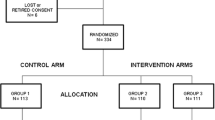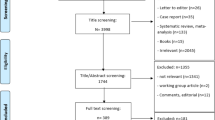Abstract
Summary
Adherence and persistence with osteoporosis medications are poor. We conducted a systematic literature review of interventions to improve adherence and persistence with osteoporosis medications. Seven studies met eligibility requirements and were included in the review. Few interventions were efficacious, and no clear trends regarding successful intervention techniques were identified. However, periodic follow-up interaction between patients and health professionals appeared to be beneficial.
Introduction
Adherence and persistence with pharmacologic therapy for osteoporosis are suboptimal. Our goal was to examine the design and efficacy of published interventions to improve adherence and persistence.
Methods
We searched medical literature databases for English-language papers published between January 1990 and July 2008. We selected papers that described interventions and provided results for control and intervention subjects. We assessed the design and methods of each study, including randomization, blinding, and reporting of drop-outs. We summarized the results and calculated effect sizes for each trial.
Results
Seven studies met eligibility requirements and were included in the review. Five of the seven studies provided adherence data. Of those five studies, three showed a statistically significant (p ≤ 0.05) improvement in adherence by the intervention group, with effect sizes from 0.17 to 0.58. Five of the seven studies provided persistence data. Of those five, one reported statistically significant improvement in persistence by the intervention group, with an effect size of 0.36.
Conclusions
Few interventions were efficacious, and no clear trends regarding successful intervention techniques were identified in this small sample of studies. However, periodic follow-up interaction between patients and health professionals appeared to be beneficial.

Similar content being viewed by others
References
National Osteoporosis Foundation, America's bone health: the state of osteoporosis and low bone mass in our nation. Available at http://nof.org/advocacy/prevalence/index.htm, accessed 12/15/2008. 2008.
United Nations, D.o.E.a.S.A., Population and Division, World Population Prospects: The 2006 Revision, Highlights, Working Paper No. ESA/P/WP.202. 2007.
Burge R et al (2007) Incidence and economic burden of osteoporosis-related fractures in the United States, 2005–2025. J Bone Miner Res 22(3):465–475
Cole Z, Dennison E, Cooper C (2008) Update on the treatment of post-menopausal osteoporosis. Br Med Bull 86:129–143
Chapurlat RD, Delmas PD (2006) Drug insight: bisphosphonates for postmenopausal osteoporosis. Nat Clin Pract Endocrinol Metab 2(4):211–219; quiz following 238
Cummings SR et al (1998) Effect of alendronate on risk of fracture in women with low bone density but without vertebral fractures: results from the Fracture Intervention Trial. Jama 280(24):2077–2082
Black DM et al (1996) Randomised trial of effect of alendronate on risk of fracture in women with existing vertebral fractures. Fracture Intervention Trial Research Group. Lancet 348(9041):1535–1541
Harris ST et al (1999) Effects of risedronate treatment on vertebral and nonvertebral fractures in women with postmenopausal osteoporosis: a randomized controlled trial. Vertebral Efficacy With Risedronate Therapy (VERT) Study Group. Jama 282(14):1344–1352
Reginster J et al (2000) Randomized trial of the effects of risedronate on vertebral fractures in women with established postmenopausal osteoporosis. Vertebral Efficacy with Risedronate Therapy (VERT) Study Group. Osteoporos Int 11(1):83–91
Chesnut IC et al (2004) Effects of oral ibandronate administered daily or intermittently on fracture risk in postmenopausal osteoporosis. J Bone Miner Res 19(8):1241–1249
Cranney A et al (2002) Meta-analyses of therapies for postmenopausal osteoporosis IX: summary of meta-analyses of therapies for postmenopausal osteoporosis. Endocr Rev 23(4):570–578
Kothawala P et al (2007) Systematic review and meta-analysis of real-world adherence to drug therapy for osteoporosis. Mayo Clin Proc 82(12):1493–1501
Haynes RB et al (2008) Interventions for enhancing medication adherence. Cochrane Database Syst Rev (2):CD000011
Cadarette SM et al (2007) Psychometric properties of the “Osteoporosis and You” questionnaire: osteoporosis knowledge deficits among older community-dwelling women. Osteoporos Int 18(7):981–989
Werner P (2005) Knowledge about osteoporosis: assessment, correlates and outcomes. Osteoporos Int 16(2):115–127
Giangregorio L et al (2008) Do patients perceive a link between a fragility fracture and osteoporosis? BMC Musculoskelet Disord 9:38
Cramer JA et al (2008) Medication compliance and persistence: terminology and definitions. Value Health 11(1):44–47
Jadad AR et al (1996) Assessing the quality of reports of randomized clinical trials: is blinding necessary? Control Clin Trials 17(1):1–12
Moher D et al (1995) Assessing the quality of randomized controlled trials: an annotated bibliography of scales and checklists. Control Clin Trials 16(1):62–73
Cohen J (1987) Statistical power analysis for the behavioral sciences. L Erlbaum Associates, Hillsdale, NJ
Cuddihy MT et al (2004) A prospective clinical practice intervention to improve osteoporosis management following distal forearm fracture. Osteoporos Int 15(9):695–700
Majumdar SR et al (2007) Persistence, reproducibility, and cost-effectiveness of an intervention to improve the quality of osteoporosis care after a fracture of the wrist: results of a controlled trial. Osteoporos Int 18(3):261–270
Shu ASM, Polinski J, Jan S, Patel M, Truppo C, Breiner C, Chen Y, Weiss T, Solomon DH (2009) Adherence to Osteoporosis Medications After Patient and Physician Education: A Post-Hoc Analysis of a Randomized Controlled Trial. American Journal of Managed Care (in press)
Cooper A, Drake J, Brankin E (2006) Treatment persistence with once-monthly ibandronate and patient support vs. once-weekly alendronate: results from the PERSIST study. Int J Clin Pract 60(8):896–905
Delmas PD et al (2007) Effect of monitoring bone turnover markers on persistence with risedronate treatment of postmenopausal osteoporosis. J Clin Endocrinol Metab 92(4):1296–1304
Guilera M et al (2006) Does an educational leaflet improve self-reported adherence to therapy in osteoporosis? The OPTIMA study. Osteoporos Int 17(5):664–671
Cook PF, Emiliozzi S, McCabe MM (2007) Telephone counseling to improve osteoporosis treatment adherence: an effectiveness study in community practice settings. Am J Med Qual 22(6):445–456
Schousboe JT et al (2005) Education and phone follow-up in postmenopausal women at risk for osteoporosis: effects on calcium intake, exercise frequency, and medication use. Dis Manag Health Outcomes 13(6):395–404
Clowes JA, Peel NFA, Eastell R (2004) The impact of monitoring on adherence and persistence with antiresorptive treatment for postmenopausal osteoporosis: a randomized controlled trial. J Clin Endocrinol Metab 89(3):1117–1123
Rossini M et al (2006) Determinants of adherence to osteoporosis treatment in clinical practice. Osteoporos Int 17(6):914–921
Balkrishnan R (1998) Predictors of medication adherence in the elderly. Clin Ther 20(4):764–771
Rollnick S, Miller W (1995) What is motivational interviewing? Behav Cogn Psychother 23:325–334
DiIorio C et al (2008) Using motivational interviewing to promote adherence to antiretroviral medications: a randomized controlled study. AIDS Care 20(3):273–283
Golin CE et al (2006) A 2-arm, randomized, controlled trial of a motivational interviewing-based intervention to improve adherence to antiretroviral therapy (ART) among patients failing or initiating ART. J Acquir Immune Defic Syndr 42(1):42–51
Schmaling KB et al (2001) A randomised controlled pilot study of motivational interviewing to change attitudes about adherence to medications for asthma. J Clin Psychol Med Settings 8(3):167–172
Ogedegbe G et al (2008) A practice-based trial of motivational interviewing and adherence in hypertensive African Americans. Am J Hypertens 21(10):1137–1143
Acknowledgments
This review was supported by the National Institutes of Health (AR-47782). Dr. Shrank is supported by a career development award from the National Heart, Lung and Blood Institute (HL-090505). Dr. Brookhart is supported by a career development award from the National Institutes of Health (AG-027400).
Conflicts of interest
None.
Author information
Authors and Affiliations
Corresponding author
Appendix 1. Calculations of Effect Size
Appendix 1. Calculations of Effect Size
For the studies (Delmas et al., Cook et al., Cooper et al., Guilera et al., Schousboe et al., Clowes et al.) for which we had the proportions (P) of the intervention and control populations who were adherent or persistent, the following calculation was used to determine effect size:
For the study (Shu et al.) for which we had the means (M) and standard deviations (σ) for adherence and persistence in the intervention and control populations, the following calculation was used to determine effect size:
As a general guideline, effect sizes ≅0.20 are considered to have negligible clinical importance; ≅0.50 moderate clinical importance; and ≅0.80 crucial clinical importance (see also Cohen 1987 [20]).
Rights and permissions
About this article
Cite this article
Gleeson, T., Iversen, M.D., Avorn, J. et al. Interventions to improve adherence and persistence with osteoporosis medications: a systematic literature review. Osteoporos Int 20, 2127–2134 (2009). https://doi.org/10.1007/s00198-009-0976-0
Received:
Revised:
Accepted:
Published:
Issue Date:
DOI: https://doi.org/10.1007/s00198-009-0976-0




